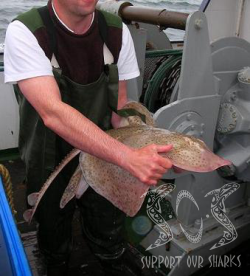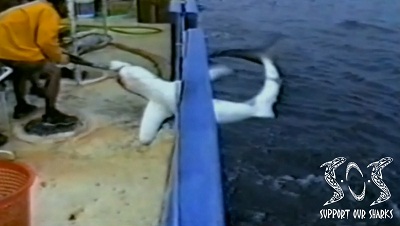 Shark
fishing for meat, cartilage and liver oil, and
the
destruction of important habitats, such as mangrove swamps and shallow lagoons
(areas
that
provide safe havens for juvenile sharks), is having devastating
effects on shark populations worldwide. Although almost every
large-scale shark fishery ends in collapse, global shark
exploitation and trade remain unregulated and no internationally
recognised management scheme exists. Some of the most
destructive and damaging fishing methods affecting shark populations
today include, gill netting, long-lines, trawling, sport fishing and
of course finning. It is not only the sharks that are affected
by these practices but many other species are also adversely
affected including rays, a close relative of the sharks.
Shark
fishing for meat, cartilage and liver oil, and
the
destruction of important habitats, such as mangrove swamps and shallow lagoons
(areas
that
provide safe havens for juvenile sharks), is having devastating
effects on shark populations worldwide. Although almost every
large-scale shark fishery ends in collapse, global shark
exploitation and trade remain unregulated and no internationally
recognised management scheme exists. Some of the most
destructive and damaging fishing methods affecting shark populations
today include, gill netting, long-lines, trawling, sport fishing and
of course finning. It is not only the sharks that are affected
by these practices but many other species are also adversely
affected including rays, a close relative of the sharks.
 Bycatch
Bycatch
Many sharks are caught as accidental bycatch in long-lines,
trawls, and nets targeting other species. Bycatch is simply
the proportion of unwanted catch returned to the sea after fishing.
Sharks are highly migratory and they often swim in groups that are
the same size and age. This can mean that a key part of the
population (mature females for example) can be wiped out in one fell
swoop. Estimates vary, but bycatch (unwanted catch) is expected to
account for a significant proportion of shark fatalities. Another
problem for sharks, known as ghost fishing, occurs when fishing gear
is abandoned and continues to catch whatever swims by. An
improvement in the species selectiveness of fishing gear is needed
if bycatch figures are to be reduced.
 Long-lines are made of monofilament and are used mainly to catch tuna,
swordfish and shark.
However, they are indiscriminate and catch many animals
other than
those targeted, including birds, sealions, sharks, dolphins, turtles
and more. Also known as
'curtains of death', long lines can range from a metres to
kilometres and are kept near the surface using floats made of styrofoam. At intervals of 30 meters or so secondary lines are
attached and baited with whatever is at hand; fish, squid or even
dolphin meat.
Long-lines are made of monofilament and are used mainly to catch tuna,
swordfish and shark.
However, they are indiscriminate and catch many animals
other than
those targeted, including birds, sealions, sharks, dolphins, turtles
and more. Also known as
'curtains of death', long lines can range from a metres to
kilometres and are kept near the surface using floats made of styrofoam. At intervals of 30 meters or so secondary lines are
attached and baited with whatever is at hand; fish, squid or even
dolphin meat.
Long-lines are a huge threat to the survival of many species of shark.
The vast majority of sharks caught by this method are killed only
for their fins; the rest of their body is discarded as "bycatch" and
thrown back into the sea. The practice of long-lining is
inextricably linked to finning. Long lining has been banned in a few
specific areas such as the US Pacific coast because of its huge
impact on ocean life, however in the vast majority of areas it is
still legal and practiced routinely.
